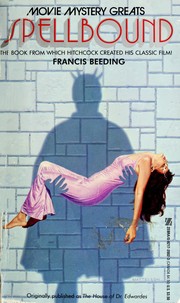Check nearby libraries
Buy this book

From the outset, the air that Beeding's characters breathe crackles with ominous electricity. This is surely what appealed to Alfred Hitchcock when he found Beeding's The House of Dr. Edwardes and used it as the inspiration for his unforgettable film Spellbound. The house of the title is a lunatic asylum in France and Dr. Edwardes is the head psychiatrist. While Edwardes is held in high esteem, an almost iconic figure in psychiatric circles, there is something clearly amiss. The novel opens with a puzzling, ominous episode in which a patient being transported to the asylum grows agitated as the car bringing him there approaches. The patiently suddenly screams: the gorge of the devil and then attacks and kills one of the supervisors, a promising but inexperienced psychiatrist. This opens a position that Dr. Sedgwick accepts, but on arrival, she learns that Dr. Edwardes has taken a leave of absence to calm his nerves. It doesn't take her long to discover that the house is hardly in order. The House of Dr. Edwardes and Hitchcock's Spellbound are both about madness, power, and terror. What is most interesting is the two very different approaches taken by each to illustrate these ideas. For Spellbound, Hitchcock borrowed heavily from Freudian psychoanalysis and its emphasis on dreams. Salvatore Dali's surrealistic interpolations are used to illustrate the more irrational aspects of the story. Beeding owes less to Freud, displaying much closer affinities with the brooding, psychological landscapes of Gothic novels of the eighteenth and nineteenth centuries, particularly Emily Bronte's Wuthering Heights. The result is a compelling work--part mystery, part modern Gothic.
Check nearby libraries
Buy this book

Previews available in: English
Subjects
Fiction, Mystery, Thriller, Thrillers, Suspense fiction, American fiction, SuspenseShowing 7 featured editions. View all 7 editions?
| Edition | Availability |
|---|---|
|
1
The House of Dr. Edwardes
2012, RosettaBooks
electronic resource /
in English
0795329008 9780795329005
|
aaaa
Libraries near you:
WorldCat
|
| 2 |
zzzz
Libraries near you:
WorldCat
|
|
3
La Maison du docteur Edwardes
January 2, 1994, Rivages
Mass Market Paperback
2869307292 9782869307292
|
cccc
Libraries near you:
WorldCat
|
| 4 |
zzzz
|
| 5 |
zzzz
|
| 6 |
zzzz
|
| 7 |
zzzz
|
Book Details
Table of Contents
Edition Notes
"Filmed as Spellbound."
Classifications
The Physical Object
ID Numbers
Work Description
The single most striking quality of Francis Beeding's The House of Doctor Edwardes is the sense of foreboding and uncertainty that pervades every scene, the hallmarks of many a great mystery. From the very first page of the prologue, Beeding makes the very air the characters live and breathe in seem to crackle with an ominous electricity.
This is surely what appealed to Alfred Hitchcock when he found in Beeding's work the inspiration for his classic, unforgettable film Spellbound. Fans of Hitchcock will want to take special notice of The House of Dr. Edwardes, for, unlike other adaptations, Spellbound strays rather dramatically from its source material. Not only do the differences offer fascinating peeks into the great director's creative vision, they also ensure that even Hitchcock fans familiar with Spellbound will find much in Beeding's novel that will surprise and delight.
The "house" of the title is in fact a lunatic asylum in France, and Dr. Edwardes is the head psychiatrist and presiding genius there. And although he is a highly esteemed, almost iconic figure in psychiatric circles, there is something clearly amiss.
The novel opens with a puzzling, ominous episode in which a patient being transported to the asylum grows agitated as the car bringing him there approaches its destination. He suddenly screams "the gorge of the devil" and attacks and kills one of his supervisors.
On the heels of this terrible and inauspicious arrival is another newcomer to the asylum, Dr. Constance Sedgwick. A promising but inexperienced psychiatrist, Dr. Sedgwick accepts a position on Dr. Edwardes's staff to learn at the feet of the great man. But she arrives to discover that Dr. Edwardes has taken a leave of absence to calm his nerves, and it does not take her long to discover that the house is hardly in order.
It is probably evident from just that short description that this work has much to say about madness, power and terror. What is interesting is the two very different paths taken by two very different artists - Beeding and Hitchcock - to best give life to these ideas. Hitchcock, as any fan of Spellbound knows, borrowed heavily from Freudian psychoanalysis and its emphasis on dreams, repression and desire. Salvador Dali's surrealistic interpolations serve as vivid illustrations of the irrational throughout the movie. Beeding, however, owes less to Freud, displaying much closer affinities with the brooding, psychological landscapes of the Gothic novels of the eighteenth and nineteenth centuries, especially Emily Bronte's masterpiece Wuthering Heights. The result is a compelling work - part mystery, part modern gothic.
The House of Dr. Edwardes is a gripping novel that continues to provoke and inspire readers and artists alike.
Community Reviews (0)
Feedback?| October 28, 2023 | Edited by mheiman | Merge works |
| October 28, 2023 | Edited by mheiman | Merge works |
| October 28, 2023 | Edited by mheiman | Merge works |
| May 31, 2011 | Edited by Sai Shankar | merge authors |
| December 10, 2009 | Created by WorkBot | add works page |













